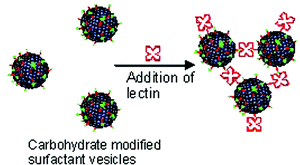Carbohydrate-functionalized catanionic surfactantvesicles: preparation and lectin-binding studies†
Abstract
In this paper we describe the modification of anionic

* Corresponding authors
a
Department of Chemistry and Biochemistry, University of Maryland, College Park, MD 20742, USA
E-mail:
deshong@umd.edu
In this paper we describe the modification of anionic

 Please wait while we load your content...
Something went wrong. Try again?
Please wait while we load your content...
Something went wrong. Try again?
J. Park, L. H. Rader, G. B. Thomas, E. J. Danoff, D. S. English and P. DeShong, Soft Matter, 2008, 4, 1916 DOI: 10.1039/B806059B
To request permission to reproduce material from this article, please go to the Copyright Clearance Center request page.
If you are an author contributing to an RSC publication, you do not need to request permission provided correct acknowledgement is given.
If you are the author of this article, you do not need to request permission to reproduce figures and diagrams provided correct acknowledgement is given. If you want to reproduce the whole article in a third-party publication (excluding your thesis/dissertation for which permission is not required) please go to the Copyright Clearance Center request page.
Read more about how to correctly acknowledge RSC content.
 Fetching data from CrossRef.
Fetching data from CrossRef.
This may take some time to load.
Loading related content
